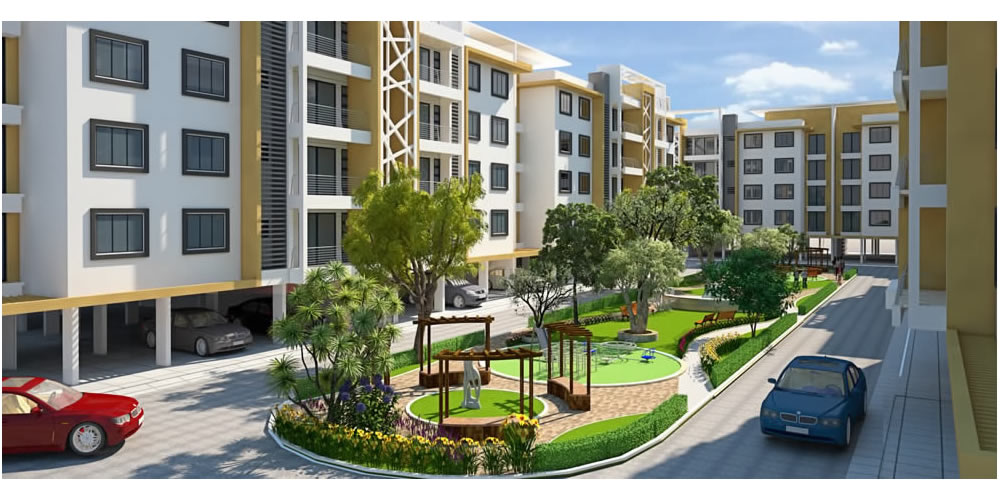Nairobi, Kenya’s vibrant capital and economic hub, is a city of contrasts, offering a spectrum of living experiences from affordable estates to luxurious enclaves. Known as the “Safari Capital of the World,” Nairobi attracts professionals, entrepreneurs, and expatriates seeking opportunities in East Africa’s economic powerhouse. However, the cost of living in Nairobi varies significantly by neighborhood, making it crucial to choose a residence that aligns with your income. With the average monthly salary in Nairobi estimated at KES 80,000 in 2024, and the cost of living rising, selecting the right estate is key to financial stability and quality of life. This comprehensive guide explores where to live in Nairobi based on your salary bracket for 2025, incorporating data-driven insights, practical advice, and recommendations for low, middle, and high-income earners. Whether you earn KES 30,000 or KES 500,000 monthly, this article will help you find the perfect Nairobi neighborhood to match your budget and lifestyle.
Understanding Nairobi’s Cost of Living in 2025
Nairobi’s cost of living is among the highest in Kenya, driven by demand for housing, transport, and essential services. According to Numbeo, as of May 2025, a single person’s monthly costs (excluding rent) average KES 65,000, while a family of four faces expenses around KES 230,000. Rent, which consumes 30-40% of household income in Kenya, is the largest expense, with prices varying by estate. The United Nations recommends allocating no more than 30% of income to rent, but many Nairobi residents exceed this due to limited affordable housing and a preference for desirable addresses.
The Kenya National Bureau of Statistics (KNBS) classifies income groups as follows:
- Low-Income: Below KES 23,670 per month.
- Middle-Income: KES 23,671 to KES 119,999 per month.
- Upper-Income: Above KES 120,000 per month.
These brackets guide our recommendations for Nairobi estates, ensuring you live within your means while enjoying access to amenities, security, and connectivity. Factors like proximity to business districts, infrastructure, and safety also influence estate suitability. With Nairobi’s population exceeding 4 million and growing at 3-4% annually, housing demand continues to drive rental and property prices, making strategic location choices critical.
Low-Income Earners (Below KES 50,000 Monthly)
For those earning below KES 50,000 per month, affordability is paramount. These individuals, often entry-level workers, small-scale entrepreneurs, or informal sector employees, prioritize low rent and basic amenities. Estates in this category offer single rooms, one-bedroom units, or shared housing, with monthly rents ranging from KES 3,000 to KES 15,000. However, sacrifices in security, sanitation, or access to clean water may be necessary.
Recommended Estates for Low-Income Earners
Based on rental affordability and accessibility, here are the best Nairobi estates for low-income earners:
- Kibera: One of Africa’s largest informal settlements, Kibera offers single rooms for KES 3,000-5,000. Ideal for those prioritizing minimal rent, but security and sanitation challenges persist.
- Kayole: A bustling estate with one-bedroom units at KES 8,000-12,000. Kayole is well-connected via matatus to the CBD and offers affordable shops and markets.
- Utawala: Located on Nairobi’s eastern outskirts, Utawala provides one-bedroom apartments for KES 10,000-15,000, with improving infrastructure and proximity to Thika Road.
- Pipeline: Popular for its low-cost housing, Pipeline offers single rooms at KES 5,000-8,000 and one-bedroom units at KES 10,000-12,000, with access to public transport.
- Githurai: Known for affordability, Githurai has one-bedroom units at KES 8,000-12,000. Its proximity to Thika Superhighway makes it ideal for commuters.
- Kawangware: Offers single rooms for KES 4,000-7,000 and one-bedroom units for KES 10,000-13,000. Markets and schools are accessible, but security varies.
- Kangemi: Close to Westlands, Kangemi provides single rooms at KES 5,000-8,000, suitable for those working in nearby commercial hubs.
- Kwa Njenga: An affordable estate near Embakasi, with rents from KES 5,000-10,000 for single rooms and KES 12,000 for one-bedroom units.
- Huruma: Offers low-cost housing at KES 5,000-10,000 for single rooms, with community-driven amenities but occasional security concerns.
Tips for Low-Income Earners
- Budget Wisely: Allocate no more than 30% of income (KES 6,000-15,000) to rent to allow savings.
- Prioritize Safety: Research estate security and opt for areas with community watch programs.
- Use Public Transport: Matatus and buses are cost-effective for commuting to the CBD or industrial areas.
- Shop Locally: Markets in these estates offer affordable food and essentials compared to supermarkets.
Challenges
Low-income estates often face issues like poor drainage, limited access to clean water, and inconsistent electricity. Residents may need to invest in water storage or rely on shared facilities. Security concerns in areas like Kibera and Huruma require vigilance, especially at night.
Middle-Income Earners (KES 50,000 to KES 200,000 Monthly)
Middle-income earners, comprising professionals like accountants (KES 486,167 annually), IT officers (KES 748,651 annually), and lecturers (KES 1,200,000 annually), form Nairobi’s growing middle class. With monthly incomes between KES 50,000 and KES 200,000, they can afford one- to three-bedroom apartments in estates with better amenities, security, and proximity to commercial hubs. Rents in this bracket range from KES 15,000 to KES 50,000, aligning with the recommended 30% of income for housing.
Recommended Estates for Middle-Income Earners
These estates offer a balance of affordability, modern amenities, and connectivity:
- South B: A popular middle-class estate with two-bedroom apartments at KES 25,000-35,000. It’s close to the CBD and has good schools and shopping centers.
- South C: Slightly more upscale, South C offers two-bedroom units at KES 30,000-40,000, with gated communities and reliable utilities.
- Imara Daima: Near Jomo Kenyatta International Airport, Imara Daima provides two-bedroom apartments for KES 20,000-30,000, ideal for frequent travelers.
- Umoja: A vibrant estate with one-bedroom units at KES 15,000-20,000 and two-bedroom units at KES 25,000-35,000, known for community spirit and accessibility.
- Buruburu: Offers spacious two-bedroom apartments at KES 25,000-40,000, with schools, churches, and shopping malls nearby.
- Donholm: Close to Eastlands, Donholm has two-bedroom units at KES 20,000-35,000, with good public transport links.
- Kilimani: A trendy area with two-bedroom apartments at KES 40,000-50,000, popular for its nightlife, restaurants, and proximity to Westlands.
- Ngong: Located along Ngong Road, it offers one-bedroom units at KES 15,000-25,000 and two-bedroom units at KES 25,000-35,000, with a semi-rural feel.
- Eastleigh: A commercial hub with affordable two-bedroom apartments at KES 20,000-30,000, though traffic and noise may be concerns.
- Roysambu: Near Thika Road, Roysambu offers two-bedroom units at KES 25,000-35,000, with modern apartments and access to TRM Mall.
- Kasarani: A family-friendly estate with two-bedroom apartments at KES 20,000-30,000, known for its sports facilities and green spaces.
Tips for Middle-Income Earners
- Negotiate Rent: Landlords in middle-class estates may offer discounts for long-term leases.
- Consider Gated Communities: Estates like South C and Roysambu provide enhanced security and shared amenities like parking and gyms.
- Balance Lifestyle and Savings: Allocate KES 15,000-50,000 for rent to save at least KES 30,000 monthly for investments or emergencies.
- Explore Outskirts: Areas like Ngong and Imara Daima offer lower rents while remaining accessible to the CBD.
Advantages
Middle-income estates provide better security, reliable utilities, and proximity to schools, malls, and workplaces. Many are near major roads like Ngong Road or Outer Ring Road, easing commutes. Gated communities in South C and Roysambu offer added safety and modern amenities like swimming pools or fitness centers.
Upper-Income Earners (Above KES 200,000 Monthly)
High-income earners, including professionals like actuaries (KES 2,342,196 annually), bankers (KES 2,048,785 annually), and CEOs (KES 650,348 annually in some firms), can afford Nairobi’s most exclusive neighborhoods. These estates, often called “blue zones,” feature palatial homes, top-tier security, and proximity to business districts. Monthly rents for 3- to 4-bedroom villas or apartments range from KES 100,000 to KES 300,000, with purchase prices from KES 60 million to over KES 100 million.
Recommended Estates for Upper-Income Earners
These neighborhoods cater to affluent Kenyans, expatriates, and diplomats:
- Karen: Known for its lush greenery and large plots, Karen offers 4-bedroom villas at KES 150,000-250,000. It boasts international schools, a golf club, and proximity to Ngong Hills.
- Runda: Home to Kenya’s largest gated community, Runda provides 4-bedroom villas at KES 200,000-300,000, with top-notch security and access to the Village Market.
- Muthaiga: An exclusive estate with 4-bedroom mansions at KES 200,000-300,000, ideal for diplomats and expats, close to the UN offices and Muthaiga Golf Club.
- Westlands: A cosmopolitan hub with luxury apartments at KES 100,000-200,000, offering vibrant nightlife, malls, and proximity to the CBD.
- Lavington: Popular for its serene environment, Lavington has 3- to 4-bedroom houses at KES 120,000-200,000, with excellent schools and shopping centers.
- Riverside: A prestigious area with modern apartments and townhouses at KES 150,000-250,000, near Westlands and diplomatic missions.
- Rosslyn: A quiet, upscale estate with 4-bedroom villas at KES 200,000-300,000, known for its proximity to international schools and the Two Rivers Mall.
- Kileleshwa: A trendy area with modern 3-bedroom apartments at KES 100,000-150,000, offering a balance of urban and suburban living.
- Ridgeways: Nestled in Karura Forest, Ridgeways provides 4-bedroom homes at KES 150,000-250,000, with access to the Windsor Golf Club.
Tips for Upper-Income Earners
- Invest in Property: With high incomes, consider purchasing homes in these estates for long-term value appreciation.
- Prioritize Security: Opt for gated communities like Runda Estate for 24/7 security and privacy.
- Leverage Amenities: Choose estates with proximity to international schools, hospitals (e.g., Nairobi Hospital), and recreational facilities.
- Negotiate Benefits: Expatriates should request housing allowances (KES 100,000+) and net salaries to cover taxes and utilities.
Advantages
High-end estates offer unmatched security, well-paved roads, and access to premium amenities like country clubs, private hospitals, and international schools (e.g., Brookhouse, costing USD 3,300-16,000 annually). Their proximity to Nairobi’s CBD and business districts like Westlands ensures convenience for professionals. Karen and Langata provide a quasi-rural ambiance, ideal for families seeking space and tranquility.
Additional Considerations for Choosing a Nairobi Estate
Transport and Connectivity
Nairobi’s traffic congestion and pothole-ridden roads can impact commutes. Estates like Westlands, Kilimani, and South C are close to the CBD, reducing travel time. For low-income earners, proximity to matatu routes (e.g., in Umoja or Pipeline) is crucial. Upper-income earners may prefer estates near major highways like Thika Road (Roysambu, Githurai) or Ngong Road (Ngong, Karen). Ride-hailing services like Uber and Bolt are widely available, with fares averaging KES 300-1,000 per trip.
Security
Security varies significantly across Nairobi. High-end estates like Runda and Muthaiga have private security and gated communities, while low-income areas like Kibera may require community vigilance. Middle-class estates like South B and Buruburu often have private security firms or police patrols, offering a balance of safety and affordability.
Amenities and Lifestyle
- Low-Income Estates: Limited to local markets, clinics, and public schools. Residents shop at affordable markets like Gikomba or Toi for clothing and food.
- Middle-Income Estates: Access to malls (e.g., TRM in Roysambu, Capital Centre in South B), private schools, and hospitals like Aga Khan.
- Upper-Income Estates: Proximity to luxury malls (e.g., Village Market, Two Rivers), international schools, and recreational facilities like golf clubs and the Nairobi National Park.
Cost of Living Beyond Rent
- Food: Monthly grocery costs range from KES 5,000-10,000 in low-income estates (local markets) to KES 20,000-50,000 in high-end estates (supermarkets like Carrefour).
- Utilities: Electricity, water, and internet cost KES 2,000-5,000 in low-income areas and KES 10,000-20,000 in upscale estates (including maid services).
- Education: Public schools in low-income areas are affordable (KES 5,000-10,000 annually), while international schools in Karen or Runda cost USD 3,300-16,000 per year.
Financial Planning Tips for Nairobi Residents
Regardless of income bracket, financial discipline is key to thriving in Nairobi’s high-cost environment:
- Follow the 30% Rule: Limit rent to 30% of your income to ensure savings and cover other expenses.
- Save and Invest: Aim to save at least KES 10,000-50,000 monthly, depending on income, for emergencies or investments like Saccos or real estate.
- Explore Suburbs: Areas like Ruiru, Ngong, or Utawala offer lower rents while maintaining access to Nairobi’s opportunities.
- Leverage HELB: Students and recent graduates can use HELB loans for education or startup capital, reducing financial strain.
- Negotiate Salaries: Professionals in high-paying sectors (e.g., finance, IT) should aim for net salaries of KES 150,000-350,000 to afford comfortable living.
Challenges of Living in Nairobi
- High Cost of Living: Nairobi’s expenses, especially rent and transport, can strain budgets, with 40% of income often spent on housing.
- Traffic and Infrastructure: Potholes and congestion, especially on routes like Thika Road, increase commuting costs and time.
- Security Concerns: Low-income estates face higher crime rates, requiring caution and community cooperation.
- Economic Disparity: Nairobi’s wealth gap means stark contrasts between affluent areas like Karen and informal settlements like Kibera.
Choosing where to live in Nairobi in 2025 depends on your salary, lifestyle preferences, and priorities. Low-income earners (below KES 50,000) can find affordable housing in estates like Kayole, Utawala, and Kibera, though they must navigate challenges like security and sanitation. Middle-income earners (KES 50,000-200,000) enjoy access to vibrant estates like South B, Kilimani, and Roysambu, offering modern amenities and connectivity. Upper-income earners (above KES 200,000) can indulge in luxury neighborhoods like Karen, Runda, and Westlands, with premium security and proximity to business hubs. By aligning your housing choice with your income and following the 30% rent rule, you can achieve financial stability while enjoying Nairobi’s dynamic urban life.





